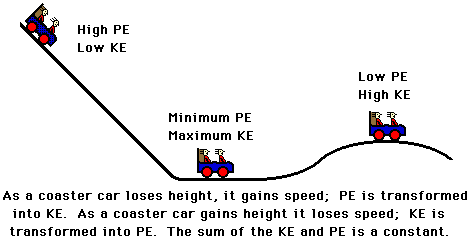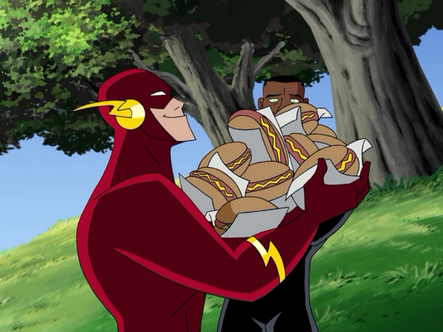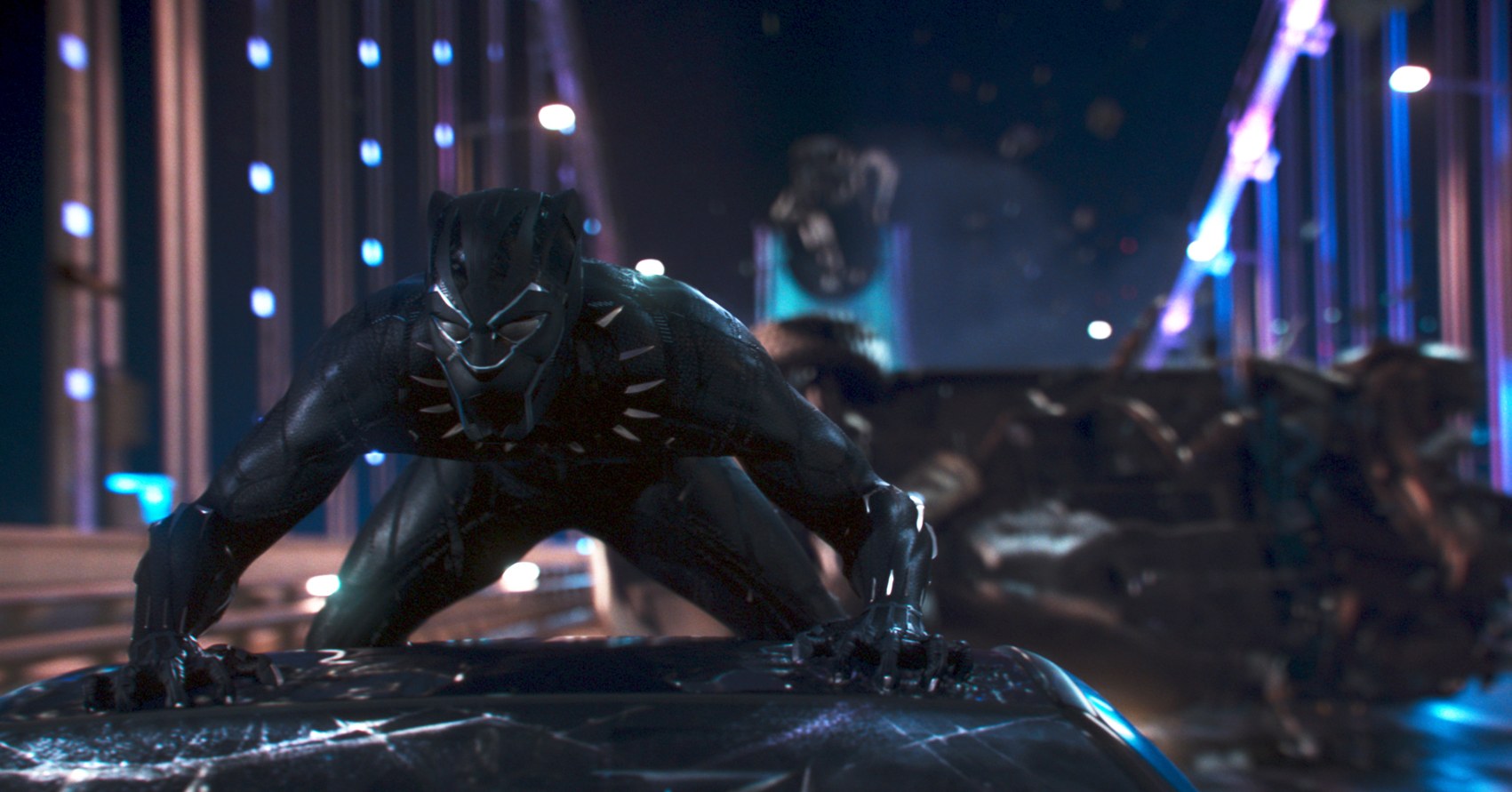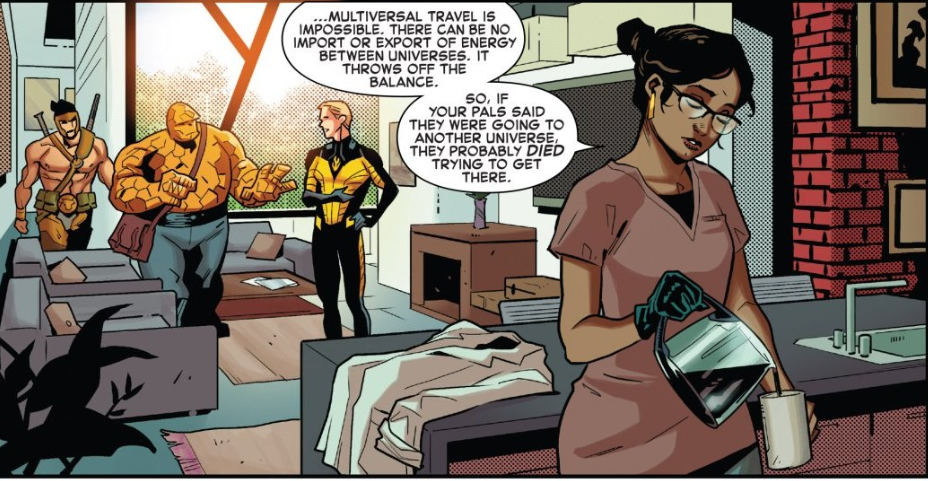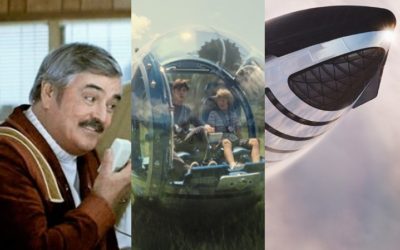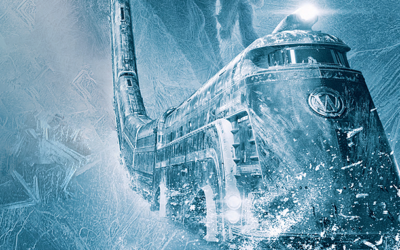Energy-wise, Marvel 2-in-One is a very bold book. Well, that’s speaking scientifically.
Let me explain.
The thing about science and superhero comics and science…okay, there are many things…but the big thing that can just cause about anyone looking to explain the physics of superheroes to bang their head on their desk in despair is energy.
Energy, as very generally described by physics is the ability to do work or cause change. Work, again in the physics sense, is achieved by the application of force over a distance. Thinking of it this way, work is a way to transfer energy. We can say that the amount of work done on an object is equal to the energy change of the object. That’s called the work-energy theorem, and we’ve used it before around here.
But speaking of energy, it’s always conserved. That means that in an isolated or closed system, energy cannot be created or destroyed, only transferred from one form into another. The total amount must always remain the same. Isolated is the key term here, and while it sounds like an easy thing to spot, it’s not always. Sometimes identifying all the pieces of a system and whether it’s closed or open (and you need to increase the scope of your “system”) takes some close analysis.
And for the physics aficionados, we’re going to keep this simple, and no get too far into conservative and nonconservative forms of energy, but just enough to say that a 100% transfer of energy between objects is pretty much impossible. You’re always going to lose some in the transfer steps. That’s your First Law of Thermodynamics. Click the links for more about any of the topics at The Physics Classroom.
When starting this concept in my physics classes, we’ll play “Follow the Energy,” where students will have to spot energy changes from thing to thing to thing. Our system for this includes a book, the floor/earth, and a lab bench. The book is on the floor. Okay, now lift it to the benchtop that’s one meter above the floor. Does the book have energy now? Yes. What kind? Gravitational potential energy, or, the energy gained by anything when it has height (gravitational potential energy = mass x gravity x height). Where did that gravitational potential energy come from?
That usually takes a couple of tries, but we narrow it down to the student. The energy that the book now has came from the student.
And of course, if the book were to fall, it would have kinetic energy (the energy of motion, kinetic energy = 1/2mv^2) while it was falling. The magnitude of its kinetic energy would grow as it fell and its velocity increased, while its gravitational potential energy would shrink as its height above the ground decreased. Finally, the book would land with a loud noise, a slight elastic deformation (a squish), and a little bit of heat produced.
The thing about energy is that all of that energy at the end – the heat, the noise, the elastic deformation – add all of those amounts of energy up, and they would all equal the kinetic energy of the book just before impact, which was equal to the gravitational potential energy when it was sitting on the bench, which was equal to the amount of energy used by the student to lift the book.
But wait – the energy came from the student? Right. The student used mechanical energy, which came from the chemical energy stored in the food they ate previously. Track it back, and students will figure out that the energy that’s contained in their bodies – that is, all the energy they will ever expend in their lives, came from the sun. Unless they live near a hydrothermal vent or are any number of bacteria that uses chemosynthesis to get their energy. But usually, the lack of arms to lift the book gives that away.
In short, the energy after must always equal the energy before. As Dr. James Kakalios states in his terrific book The Physics of Superheroes, “We have never been able to catch nature in a slipup where the energy at the start of a process does not exactly equal the energy at the end. Never.”
Okay, okay – before we start talking about conservation of energy and superheroes, let’s just take a minute. Run through every complaint you might have in your head: This is made up so it doesn’t matter! It’s not supposed to be real! You’re ruining the fun! Who cares about this anyway?
Heard ‘em all, know them all. But add to it, why not use something with an inherent “cool factor” like comics and superheroes to talk about something that’s pretty neat, and one of the fundamental rules by which the universe works?
At least that’s how I see it. YMMMV, of course, but I’m always looking for something to help my students and anyone grasp ideas about science, so if they’re wrapped up in something cool like superheroes – that’s awesome. To continue…let’s explore the conservation of energy with superheroes.
Relative to comics, conservation of energy is a neighborhood where angels should fear to tread. It’s often the start of silly, comic book-y science. Case in point – how much does the Flash eat to run as fast as he does? Give a speed at which the Flash runs, estimate his mass, and you can calculate his kinetic energy. Where does that energy come from? If you say “his food” because of conservation of energy, you’ve got a Flash that’s carrying around huge trays of food, and as we explored, starving people just so he can run fast. That’s silly. If you ever write comics, science fiction novels, TV or movies, please don’t do that.
The better answer to how the Flash is able to run as fast as he does? The Speed Force. It’s “magic,” it’s undefined and more than that, it resists definition, so it can do everything you need it to. Heck, as the television series shows, you can even vacation in it when it takes the form of your dead mom. Bingo. Case solved, and conservation of energy bullet dodged.
Or, in an example where conservation of energy is used well – Black Panther’s vibranium suit which allows him to absorb kinetic energy for later release as a force blast. Over at WIRED, physics professor Rhett Allain took a look at the claim, and found that it actually works out. Getting hit by bullets, and absorbing their kinetic energy could provide enough energy to lift a car up into the air. The middleman in this case is the vibranium, which acts like the Speed Force – it’s not real, so it can do whatever you need it to do. In this case, the energy before (from the bullet impacts) was more than enough to equal the energy after (to lift up a car).
Or in an example where it’s used not so well…Superman. Solar-charged, right? When you do the math, there’s just no way. The energy he’d get from the sun hitting his skin, even if his cells had some kind of super-super efficient solar cells in them isn’t enough to power him to do the things he does, let alone just the human things he has to do. More to the point with Superman and energy, if he’s solar powered, and his solar cells are in his skin, why does he show about as much skin as…well, a nun? If you’re solar-powered, you need maximum skin exposure. Borrow Wonder Woman’s costume, buddy. Your powers are magic.
All of this goes to the point that when trying to explain the energy flow in a comic book universe, it’s a tricky business, and most often best served by a full “magic” explanation like the Speed Force or a magical middleman like vibranium.
And this brings us to someone in the Marvel Universe who’s actually worried about the Principle of Conservation of Energy – Rachna Koul.
To set things up, Reed Richards (Mr. Fantastic), Sue Storm (Invisible WOman) and their kids (Franklin and Valeria) are missing and presumed dead while Ben Grimm (the Thing) and Johnny Storm (the Human Torch) are alive and well (not really) on earth. The hunt for the missing teammates has been the focus of Marvel’s Marvel 2-in-One title written by Chip Zdarsky. Developments revealed to date include that Johnny is losing his powers, and is weaker now than he has been in years. Also, Ben may have lied to Johnny about the possibility of Reed, Sue and the kids still being alive.
In issue #3 Ben and Johnny catch up with Hercules for some help in getting Johnny’s powers back. As Hercules explains it, when his powers were diminished, he sought help on earth, rather than ask his father, Zeus for the powers back. Herc takes the two to meet Rachna Koul (yay! diversity!), a brilliant (but to date, under-the-radar) scientist who works in “Imperiumology.” In her words:
“It’s biology, but related to ‘powers,’ whether mutant, accidental or – in the case of Hercules – ‘God Power.’ Every case is different.”
In short, if there’s a problem with your powers, she can fix it. For a hefty price.
In explaining how she “fixed” Hercules, Koul explained that despite what he still may think, he doesn’t have some form of always-replenishing “god power” inside him, but rather his biology links him to a source for the power he uses. Koul continues:
“The laws of physics don’t support you taking in enough energy to expend that kind of energy. You blew out all of your power and damaged the conduit. I simply repaired that, like reopening a tap to your fuel.”
See? Conservation of energy at work.
For Hercules to perform any feat of superheroics, he would need energy. Explaining where that energy came from – as pointed out above – can get hairy. So, instead of treating Hercules like a closed, isolated system, this explanation opens Hercules up. He’s not a closed system, the system includes him, but also the source of his power, and some form of conduit connecting the two. What’s the source? Who cares? The conservation of energy problem was dodged.
Not content for dancing with Conservation of Energy just the one time, Zdarsky double-dips in the minefield of physics and comics later in the issue when travel between universes is brought up. As Koul says:
“…multiversal travel is impossible. There can be no import of export of energy between universes. It throws off the balance. So, if your pals said they were going to another universe, they probably died trying to get there.”
Yeah – she’s cold.
But here’s the thing – Koul is considering the universe she’s in, and every other universe within the Marvel multiverse a closed system, and thus, the total amount of energy within each universe must remain constant. Any attempt to bring energy into the system or remove energy from the system wouldn’t be allowed. Same with matter, but that’s a different article.
(And yeah – okay, for Koul to say this implies that she’s forgotten the events of the Secret Wars event when versions of other earths were literally appearing next to each other and literally crashing into each other, and literally causing the heads of anyone who was playing with the science, to explode. Koul must’ve missed that. See also, Miles Morales, et. al.)
But Koul’s thinking about conservation of energy is very “real world” meaning our world, but honestly, cosmologists and physicist are on the edge of thinking that our world might actually exist in a multiverse, so not much thinking has gone into the application of conservation of energy between them. We like to think that the total amount of energy in our universe is constant, we honestly have no idea if Conservation of Energy applies to just our universe, or the possible multiverse. We have some ideas, but no means to even perform the most basic experiments to test the different hypotheses.
But to be fair to Koul’s thinking, in her world, it makes sense. Each universe is a closed system, and her experience is all about tracking energy and making it flow again. That’s what makes sense to her.
But the thing is, we, as Marvel readers have seen, and both Ben and Johnny have been in other universes. It does work within the Marvel Universe greater cosmology – the Marvel Universe, the “616” to the hardcore fans, isn’t a closed system. The Marvel multiverse is perhaps the closed system. Trips between universes have been seen and undertaken hundreds, if not thousands of times. And this is somewhat supported by the idea that in the greater Marvel Universe, all of reality is embodied by two beings, Infinity and Eternity. Maybe those are the closed systems in which the conservation of energy rules must apply?
And to be fair to Ben and Johnny, Koul’s revelation about the possibly deaths of Reed, Sue and the kids didn’t seem to phase them. In response, Ben pulled out the Multisect, a device left by Reed to help Ben and Johnny travel between universes. As Ben said,
“Look, maybe you’ve heard of a guy named Mr. Fantastic? ‘Cause doin’ the impossible is kinda his thing.”
Right on, Ben.
You want a bet for a multiverse where the energy flow between universes is all screwed up? I’d look towards DC’s Batman: Metal event with its Dark Multiverse for that. But that’s an article for another time.




